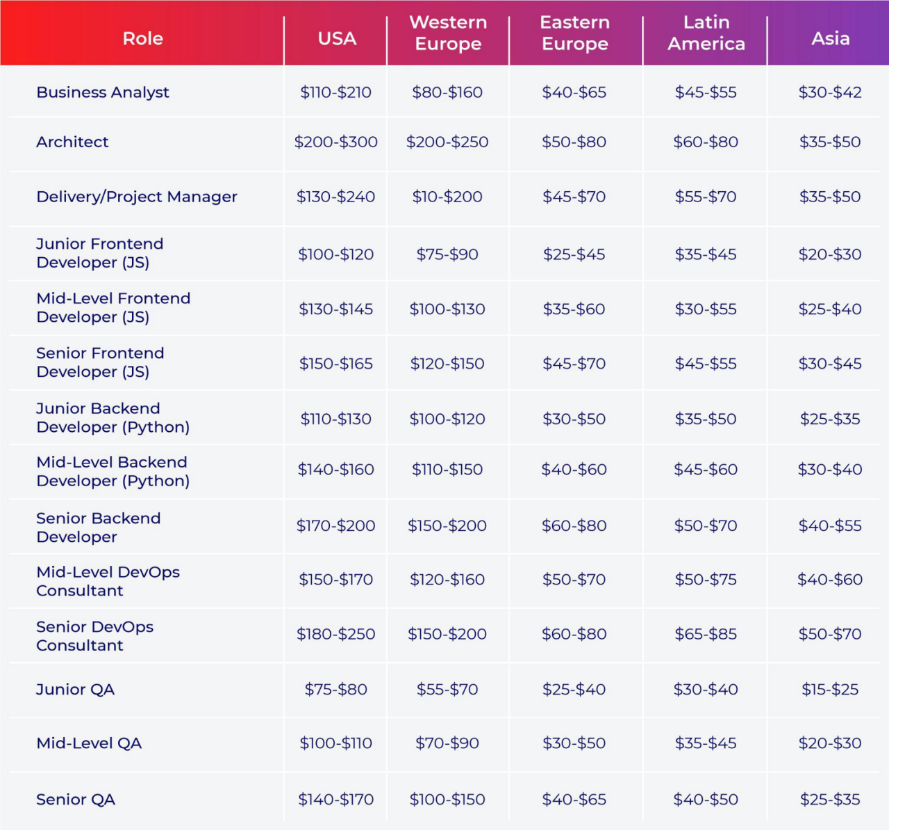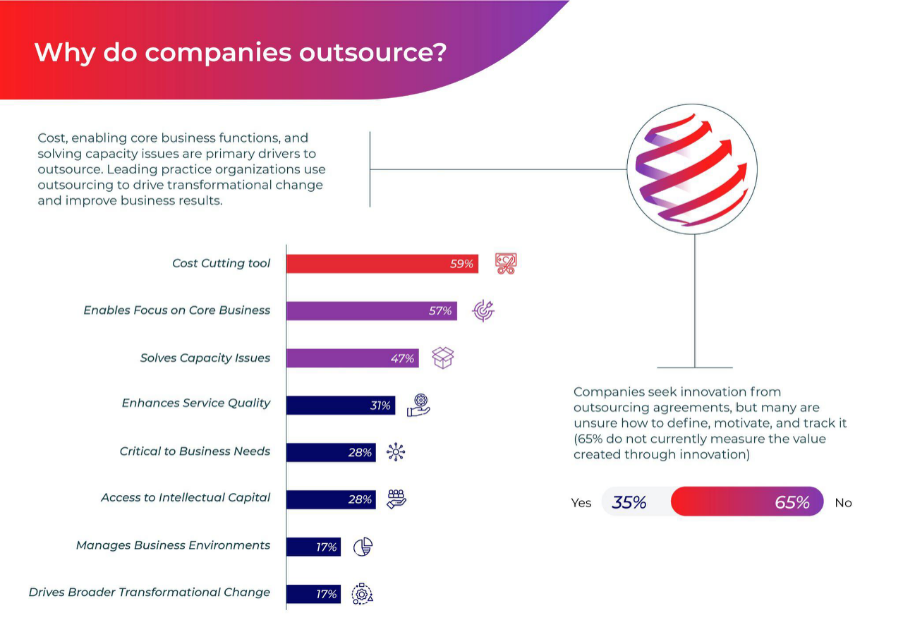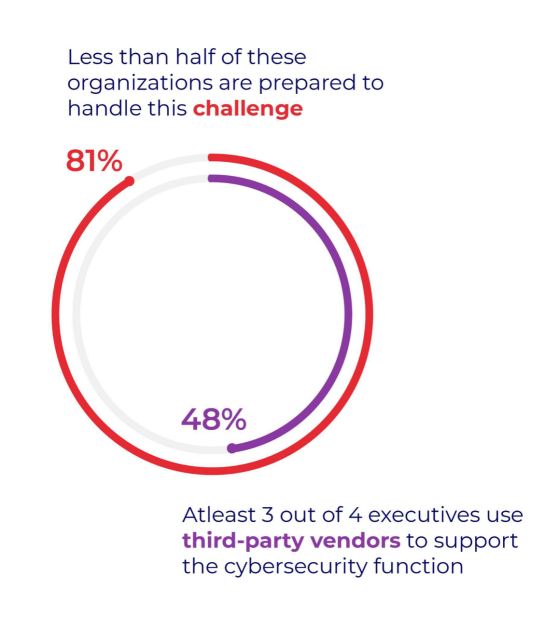The early days of outsourcing (way back in the 1980s) involved companies relaying part of their IT functions to service providers who were based in low-cost countries (including Asian countries like India, China, and the Philippines). This meant impressively low costs for outsourcing companies. It also meant the unreliable quality of service and major communication inefficiencies due to geographical, cultural and time zone differences.
Today, software development accounts for 64% of outsourced services worldwide (Source – Statista). This is due to the spurious growth of specialized skill sets across different regions around the world, especially countries that are ‘nearshore’. Nearshoring is the outsourcing of IT or business processes to countries that are geographically close to the company’s main market.
The nearshoring outsourcing model has taken the IT services industry by storm thanks to the elevated quality of services and communication while keeping costs low. In fact, the average hourly rate for nearshore software development is 46% lower than onshore rates (Source: HatchWorks). Further, nearshore outsourcing will add over $78B to the export sector in Latin America after 2023 (Source: IADB).
Let’s take a closer look at what nearshoring is and why more businesses, both small and large, are gravitating towards it as their primary outsourcing model.
Nearshoring – what it means and why it matters
Nearshoring is about much more than just cost savings. It’s about finding the right partner to help you build a strong IT foundation and support your business goals in the rapidly evolving digital landscape. Businesses are facing a multitude of challenges that require an agile and resilient IT foundation to stay ahead of the curve.
In many cases, nearshore providers can offer services at a fraction of the cost of their onsite counterparts. This can be especially attractive to small and medium-sized businesses that may not have the budget to hire staff in-house or to outsource to more expensive firms. In fact, 21% of small businesses looking to outsource intend to hire a nearshore company, up from 15% the previous year (source: Clutch).
Cost Comparison of Nearshore Outsourcing Destinations Compared to Offshore and Onshore (IT Roles)
There are several factors to consider when nearshoring, including:
- The country’s proximity to the company’s primary market. According to Accelerance, US-based companies seek nearshore talent in Latin America and Canada because of a close workday overlap, strong cultural fit, and high English language proficiency. Proximity is important for two reasons:
- it reduces the time and cost of travel for face-to-face meetings.
- it makes it easier to stay in touch with current events and trends in the target market.
- The access to specialized skillsets and talent. 50% of executives identify talent acquisition as a top internal challenge in meeting their organization’s strategic priorities (Source: Deloitte).

Canada is another popular choice for nearshoring IT services given its highly skilled labour and a consistently growing technology sector (over 40,000 companies in the software and computer services industries).
Further, the rise of the gig economy means an increasing number of freelancers and contractors who are available for short-term projects.
- Time zone differences.By choosing a location that is in a similar time zone to your own, you can maximize efficiency by having workers available during your off-hours. This can be crucial for businesses that need 24/7 customer support or other around-the-clock services.
- The country’s political and economic stability.
In Latin America, rates surged by 24% due to escalating labour costs and an influx of clients exiting partnerships in Ukraine (source: Accelerance)
A country’s political stability can impact the reliability of its infrastructure and the availability of skilled labour, while economic instability can lead to higher costs and currency fluctuations. As such, it’s critical to choose a nearshore destination that is politically and economically stable. This will help ensure that nearshore operations run smoothly and efficiently without encountering any significant setbacks.
The nuts and bolts of nearshore outsourcing
There are a few different ways to go about nearshoring IT services. One option is to outsource your IT operations to a third-party provider that has development centres located in the same country as your business. Another option is building or leasing your development centre space in a nearby country.
The nearshoring process usually begins with a needs assessment, during which businesses identify the specific IT requirements they wish to outsource. Once these requirements have been identified, a service provider is selected and contracted. The provider will then establish a delivery centre in the target country and begin delivering the agreed-upon services.
Nearshoring arrangements are typically long-term contracts that span several years. However, they can be customized to meet the specific needs of each business. For example, some companies opt for a partial nearshore solution in which only certain functions are outsourced. In contrast, others choose to outsource their IT operations fully.
Why consider nearshore services for your business
Other than the obvious cost benefits associated with nearshoring, it does open new pathways for growth for businesses. “Enabling focus on core functions” is the most common perceived benefit among companies that use outsourcing (Source – Deloitte)
Today, software developers from Latin America and Canada (two of the major choices for outsourcing IT services) are among the top-rated globally (Source: HackerRank). When it comes to communication, Latin American countries consistently rank moderate to high on the English Proficiency Index (Source: Statista).
This translates into greater flexibility, collaboration and coordination among different teams, and access to skilled labour. It’s no surprise then that 80% of companies in North America are actively considering nearshore (Source: Bloomberg).
Let’s take a deeper dive into why nearshoring might be the ideal outsourcing model for your IT needs –
- Improved communication and collaboration:Nearshore companies are often located in countries where English is the primary language, or common enough for professionals to communicate effectively. In fact, English speakers in Latin American countries have the fastest rate of improvement in the world (Source: Education First) This is not always the case with offshoring, where companies may have to rely on translation services to communicate effectively with their IT providers. Communication with a nearshore provider is typically easier due to closer geographical proximity and shared cultural values. This can lead to improved project management and a better overall working relationship.
- Enhanced security:In an age where data breaches are becoming increasingly common, it’s essential to have a strong IT foundation that can withstand any attack. One of the benefits of nearshoring is that it allows businesses to keep their sensitive data within their own country’s borders, which can help to improve data security. By having a team of experts who are constantly monitoring your systems and working to improve your security infrastructure, you can be confident that your data is safe.
- Increased flexibility:Nearshoring allows businesses to quickly and easily scale up or down their IT services as needed without making major changes or investments. This can be a real advantage when businesses face unexpected changes or challenges. This flexibility can help businesses save money on IT costs by avoiding over-provision for future needs or keeping extra staff on hand to cover unexpected spikes in demand.
Nearshoring can also provide businesses with more flexible staffing options. Rather than being locked into a long-term contract with a single provider, businesses can work with multiple providers on a project-by-project basis. This allows businesses to tap into a wider pool of talent and expertise as needed and provides them with more flexibility when it comes to managing their budget.
- Superior quality: This is because nearshore providers can offer more personalized service and are better placed to understand the specific needs of their clients. Nearshore service providers are often located in countries with well-developed infrastructure and high-quality talent pools.
- Access to new markets:By nearshoring, businesses can expand their customer base by tapping into new geographies and customer segments. Additionally, they can launch new products and services more quickly to meet the needs of these new markets.
- Increased speed to market: When businesses work with service providers in nearby countries, they can get products and services to market faster. This is because there is less time difference between the two locations and fewer logistical issues to deal with.
Nearshoring – A winning outsourcing model marrying cost-savings with quality and collaboration.
As businesses face increasing pressure to do more with less, many are turning to nearshore IT services to increase market speed and improve efficiency. By nearshoring IT services, businesses can take advantage of the increased flexibility and agility that comes with working with a smaller, nimbler partner.
This is why NULogic is at the forefront of delivering superior nearshoring services to catalyze collaboration and help you stay a step ahead of your competitors. Our robust network of nearshore offices in Canada and LATAM has been instrumental in offering high-quality project delivery and fostering seamless collaboration among IT teams.
To learn more about our nearshore services, contact us at sales@nulogic.io.






